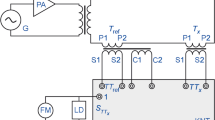Abstract
Reference-level measuring instruments (working standards of the first and second digits) play a role in ensuring the uniformity of measurements of harmonic distortion, namely, the transfer of a unit of harmonic distortion from the primary standard to all measuring instruments from a huge fleet of working measuring instruments. There is a need for a continuous search for ways to reduce the error of these measuring instruments. In this work, methods for reducing one of the components of the measurement tool error of the reference level, namely, an additional error caused by distortions in the measuring cable due to a mismatch of the resistances at the calibrator output and the input of the meter, are examined. Until recently, the influence of measuring cable parameters on the results of harmonic distortion measurements has been considered negligible because harmonic distortion measuring instruments operate at sufficiently low frequencies (less than 1 MHz). However, for modern reference-level measuring tools, such an effect has become noticeable and warrants an investigation. For calibrators with large output impedance (600 Ω), which significantly exceeds the characteristic impedance of the measuring cable, the additional error due to distortion in the measuring cable can be significant. An analytical dependence of the indicated error on the parameters of the measuring cable, the calibrator signal, and the output resistance of the calibrator is derived. Conditions are established under which this additional error is absent or can be ignored due to its smallness. When testing harmonic distortion measuring instruments, a measuring cable 1 m long with a characteristic impedance of 50 Ω is frequently employed. For a cable with these parameters and different output resistances of the calibrator, we calculate and experimentally evaluated the indicated additional error. For a signal with a harmonic fundamental frequency of 200 kHz and a uniformly decreasing distribution of harmonic levels with a calibrator output impedance of 600 Ω, the additional absolute error is 3% in generating a harmonic distortion equal to 100%. The use of factory corrections for the total error in the formation of harmonic distortion of the manufactured calibrator allows only a partial reduction of the additional error. To significantly minimize the additional error of the calibrator used, using the measuring cable supplied with the calibrator or a cable with identical parameters is needed. The experimental estimate of the additional error agrees well with the calculated value. This work recommends considering the additional absolute error in the formation of harmonic distortion when develo** and testing instruments for harmonic distortion measurements.



Similar content being viewed by others
References
Bezdenezhnykh, S.V.: “Features of metrological support for harmonic coefficient measuring instruments on a digital basis,” Almanac Modern Metrol. No 2(18), 192–213 (2019)
Ju, A.: Bryuhanov. Ju. A. Lukashevich “nonlinear Distortion Harmon. Signals Quantization” radiotekhnika No. 10, 57–60 (2009)
Gritsutenko, S.S.: Quantization of sine signals. vestn. Izhevsk. Gos. Tekhn. Univ. No 4(48), 173–176 (2010)
O. Heaviside, Electromagnetic Theory, the Electrician Company, London, 1, 466 (1893).
Kharkevich, A.A.: Basics of Radio Communication, 3rd edn. reprint, Fizmatlit Publ, Moscow (2007)
Bessonov, L.A.: Theoretical Foundations of Electrical Engineering. Electric Chains. Vysshaya shkola Publ, Moscow (1996)
Ulakhovich, L.A.: Fundamentals of the Theory of Linear Electrical Circuits. BHV-Petersburg Publ, St. Petersburg (2009)
David, M.: Pozar Microwave, 4th edn. Engineering, John Wiley&Sons Inc, USA (2012)
Kudinov, I.V.: “Receiving and research of the analytical solution of the cable equation for conductors with the distributed parameter,” Bull. Samara State Techn. Univ. Series Techn. Sci (1), 109–121 (2017)
Zh, A.: Kokozova, “Practical applications problem telegraph equation and methods for their solution,”. No, vol. 7. Nauka, Nov. Tekhn, pp. 30–36 (2014)
A. Ia. Iakushev, A. G. Sereda, M. N. Vasilenko, et al., Russ. Electr. Eng., 88, No. 10, 643–648 (2017). https://doi.org/10.3103/S1068371217100157.
Kozhanov, A.I., Safiullova, R.R.: Determination of parameters in telegraph equation. Ufa Math. J. 9(1), 62–74 (2017). https://doi.org/10.13108/2017-9-1-62
Platonov, F.A., Akhrameeva, E.O., Babarykin, V.A., Pruglo, A.V., Bezdenezhnykh, S.V., Kaminskii, O.V., Stal’nova, K.A.: Meas. Techn., 59. No 3, 203–208 (2016). https://doi.org/10.1007/s11018-016-0943-z
Belorussov, N.I., Saakian, A.E., Iakovleva, A.I.: Electrical Cables, Wires and Cords. Energoatomizdat Publ, Moscow (1988)
Author information
Authors and Affiliations
Corresponding author
Ethics declarations
Conflict of interest
The authors declare no conflict of interest.
Additional information
Translated from Izmeritel’naya Tekhnika, No. 12, pp. 40–46, December, 2023. Russian DOI: https://doi.org/10.32446/0368-1025it.2023-12-40-46
Publisher’s Note
Springer Nature remains neutral with regard to jurisdictional claims in published maps and institutional affiliations.
Rights and permissions
Springer Nature or its licensor (e.g. a society or other partner) holds exclusive rights to this article under a publishing agreement with the author(s) or other rightsholder(s); author self-archiving of the accepted manuscript version of this article is solely governed by the terms of such publishing agreement and applicable law.
About this article
Cite this article
Bezdenezhnykh, S.V., Stal’nova, K. Harmonic distortion calibrator: additional uncertainty due to distortion in the measurement cable. Meas Tech 66, 940–948 (2024). https://doi.org/10.1007/s11018-024-02310-4
Received:
Accepted:
Published:
Issue Date:
DOI: https://doi.org/10.1007/s11018-024-02310-4



